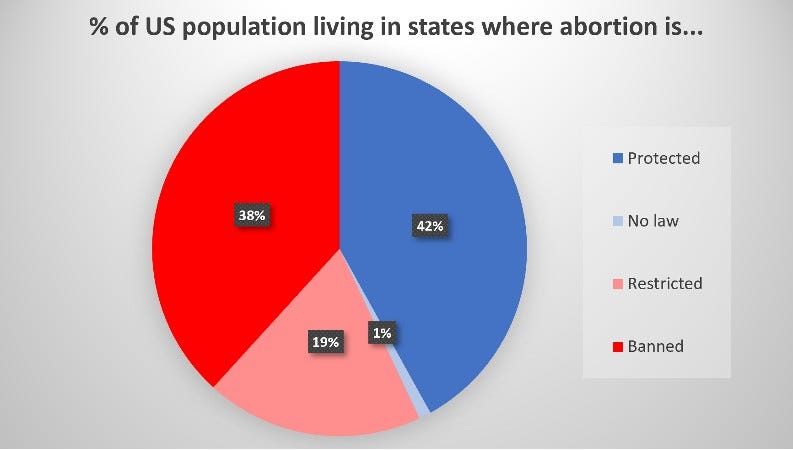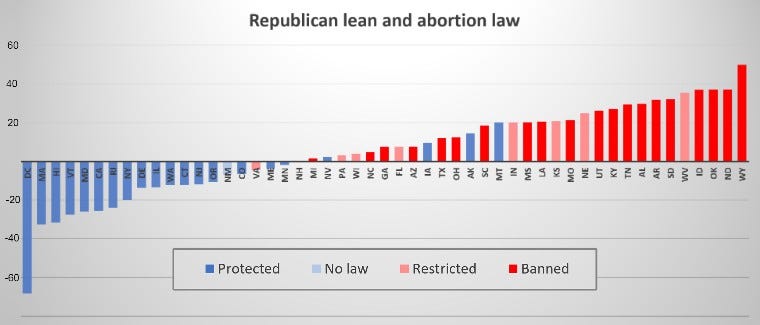I think abortion should be legal, so I’m unhappy that it will probably soon be illegal in many parts of the country. I don’t really feel mad because I’ve already been through that; this outcome was one of the reasons why I was mad when Mitch McConnell wouldn’t hold hearings for Merrick Garland. It was one of the reasons why I was mad when Trump won. And it was one of the reasons why I was mad when people said it was sexist to suggest that an octogenarian with chronic health problems should retire instead of imagining that you can girlboss away cancer using dumbbells and sassy sweatshirts.
The future of abortion lies with state and federal legislatures. What does that future look like? If you’re in the market for some wild-ass guesses that have an aura of statistical legitimacy but that also possess an asterisk the size of a supermassive black hole, please keep reading. I’ll try to pick out a few scant beacons that are visible through the fog. Of course, I should also note that none of us know how this ruling will change the politics of abortion; it will have ripple effects that are impossible to predict, which is basic chaos theory, which is the one mathematical theory that everyone knows because it was in Jurassic Park.
So, let the pointlessness begin. Right now — using categorizations from NBC news1 — 20 states have laws that would ban abortion if Roe is repealed. 21 states (including DC) would explicitly protect abortion, and eight would impose some restrictions. Two states have no laws on the books, which happen to be the two states in which Walter White claimed residency: New Mexico and New Hampshire. Please leave your theories about the connection between abortion laws and the Breaking Bad antihero in the comments section.
Pairing those characterizations with data from the 2020 census, we see that the percentage of Americans living under various laws will probably soon look like this:
The states that allow and disallow abortion are pretty much the ones you would guess. So, if you thought that explaining this data set would require a complex theory that, say, differentiates social conservatism from populist conservatism, or that factors in regional ideocracies…nope! Place that Excel sheet in a folder labeled “wasted time”, you pedantic dweeb. A simple Republican/Democratic lean analysis explains the data very well. Here are the state-by-state laws along with 538’s calculation of each state’s Republican lean (so, a big negative number represents a very blue state, and a big positive number is a very red state):
Partisan lean explains each state’s abortion laws very well, but there are still a few “mismatch” states. For example: Montana has a +20 Republican lean — which makes it exactly as Republican as New York is Democratic — but also has a law protecting abortion. Do any of these states seem likely to “realign” themselves now that state abortion laws are suddenly very important? Yes — I’ve identified seven candidates:
Montana has a +20 lean, big GOP majorities in both state houses, and their governor is that nutcase who body-slammed a reporter. They seem likely to go from “protected” to “banned”.
New Mexico leans Democratic, has solid Democratic majorities in both houses, and has a governor who just called for a state law protecting abortion. The first of Walter White’s states of residency seems likely to get on the record soon.
Iowa is +9.7 Republican, has solid GOP majorities in both houses, and has a governor who has been vocal about repealing Roe v. Wade. They’ll probably switch from “protected” to “banned”.
Florida has Republican majorities in both houses. Also, their governor is trying to win the GOP nomination for president, so obviously he has to sign any anti-abortion law put in front of him, no matter how extreme. Republicans in the legislature have already made noises about banning abortion altogether, so I’m tipping Florida to move from “restricted” to “banned”.
Indiana has huge, corn-fed Republican majorities in both houses, and they’re already making noises about moving from restrictions to a full ban. Their Republican governor is noncommittal but has signed anti-abortion legislation before. It seems likely that Indiana could institute a full ban.
Nebraska’s legislature only has one house, and it tilts Republican. Their governor is already saying that he wants to pass a new abortion law; they seem almost certain to move from “restricted” to “banned”.
West Virginia has a legislature that is mostly Republican, and my extensive research has revealed that 100 percent of them are West Virginia Republicans. Their West Virginia governor recently signed a West Virginia law restricting abortion in West Virginia. This Republican +35.5 state seems extremely likely to move from “restricted” to “banned”.
If I’m right about these states — and I’ve been right once before — then this “realignment” would cause the percentage of Americans living under various laws to shift like this:
What about federal law? Is there any chance that either party will summon a filibuster-proof majority to pass a law allowing or banning abortion any time soon? For Democrats, the answer is very simple: No. And if you’re thinking “But what if…”, the answer is still “no”. And if that makes you ask “Have you considered…”, my response is “yes, I did, and I still came back to ‘no’”. There are theories of physics that posit the existence of multiverses more numerous than the human mind can comprehend, and yet I’m still 100 percent confident that there is no universe in which Democrats will muster 60 Senate votes to protect abortion in the next few years.
That’s because the next two election cycles are really rough for Senate Democrats. Midterm elections usually punish the party that holds the White House, and recent polling suggests that this cycle might be college-improv-show-level brutal for Democrats. 538 thinks that Democrats would do well to still have 50 votes in the next Congress (and two of those votes would be Joe Manchin and Bob Casey, who recently voted against codifying abortion rights). 2024 also looks tough for Democrats: They have to defend 23 Senate seats to Republicans’ ten. 2026 will be the earliest possible moment that Democrats can dare to dream about a filibuster-proof majority, and even that will require major damage limitation in ‘22 and ‘24.
What about Republicans? Republicans’ path to 60 votes is easier, but still very hard. Suppose that Republicans win all seven seats that 538 says are in play in 2022: That would give them a 54-46 majority. As mentioned, they have many more opportunities than Democrats to flip seats in 2024, but how many of those seats will be competitive? Quite a few, actually: 12 seats are a Democratic incumbent in a state that has less than a ten point Democratic lean. In fact, eight of those 12 states lean Republican. Meanwhile, Republicans have to defend only one seat with less than a +10 Republican lean, and it’s Florida (R+7.6). Assuming that Republicans need to get to 62 votes to pass a filibuster-proof ban (because they won’t get Collins and Murkowski), and assuming that they run the table in competitive races in 2022, they’ll need to win eight out of 12 competitive seats in 2024 (and hold Florida). That’s unlikely, but not impossible. They’d also need to win the White House, but it’s hard to imagine them winning 2/3 of competitive Senate seats but somehow still losing the White House. Though Trump might be able to pull it off.
What about scrapping the filibuster and passing something with 50 votes? That won’t happen soon for Democrats; Manchin and Sinema would have to change their position on the filibuster, and Manchin and Casey would have to change their position on abortion (unless Democrats can pick up Murkowski and Collins, which they probably can’t). Chuck Schumer has announced that the Senate will hold a roll call vote on abortion so that “every American will get to see on which side every senator stands.” Surely, this will be the moment that the progressive left will come to understand: You can’t pass legislation if you don’t have enough votes. It’s not about “standing up” or “fighting” — it’s about votes. This will definitely stop extremely stupid people on Twitter from whinging about how they’re never voting for a Democrat again because Democrats can’t get anything done, which, of course, is a major factor keeping Democrats from getting anything done. And I hope the sarcasm in the last few sentences is apparent, because I really don’t know how to lay it on any thicker.
Republicans can’t pass an abortion ban with Biden in the White House, so their focus will be on 2024. If you think that Republicans will keep the filibuster because they’ve spent the past few years singing its praises, then I find your faith in their integrity downright adorable. You’re like Bart Simpson with Krusty the Clown — you just never stop believing! That being said, Republicans didn’t scrap the filibuster when they had a narrow majority in 2016, reportedly because a few in the GOP caucus wanted to keep it. They’ll probably need a majority in the mid-50s to get rid of it, but if they do well in 2024, that will be an option.
About half of the country will probably live in places where abortion is illegal for at least the next few years. This is a somewhat strange outcome in a country where various polling methods continually find solid majorities supporting legal abortion. The wild card in my calculations remains the chaos theory component: Will the politics of abortion change now that abortion opponents can write their beliefs into law? Will large numbers of Republicans suddenly decide that — um, on second thought, an outright ban seems extreme, so maybe just banning abortion in some cases would be better? We’ll see. Americans haven’t voted for politicians who possess the power to make major changes to abortion laws for 50 years. With that being true, there’s only so much that the numbers can tell us about what will happen next.
There’s some subjectivity in these characterizations — the NBC News article sorts through some of that.






Walter White showed both that it is dangerous to leave people without any healthcare whatever, and that someone who needs a medical procedure might unexpectedly turn into a drug dealer. So abortion was kept legal, but simultaneously, restrictions were added accross the healthcare system so crime lords have fewer incentives to use hospitals for money laundering. If this sounds like a stretch, think about the cost of healthcare in the US, and consider the metric tons of money you could whitewash with just a little tweaking. I'll never understand why so-called criminal geniuses went for KFCs and car washes instead of thinking bigger.
I’m opposed to scrapping the filibuster, as any law passed with 50 votes could just get undone as soon as the Senate changes hands in 5 minutes. That said, Collins and Murkowski have a bill that is all of 3 pages long that “codifies” Roe and Casey, and Schumer “hasn’t read it yet.” If Dems can’t/won’t iron out a compromise that would pull Collins and Murkowski in, then fuuuuuuuuuuuuuck them. C & M are asking for only a couple of extremely reasonable things. Now, I know this still wouldn’t get 60 votes but Jesus Christ, at least try. Otherwise you’re proving, yet again, that you’re really just jazzed about this being midterm election fodder and you don’t actually give a crap about abortion access, just like you didn’t actually give a crap about passing the George Floyd Justice in Policing Act (yeah I’m still mad!)